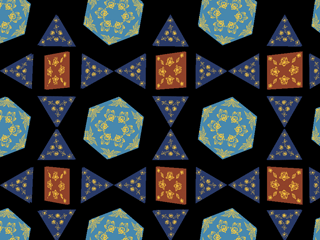Kim Ash
Identity Motion
Identity Motion is a screen-based work that explores the math of symmetry in the form of a moving mosaic.

Classes
Thesis
Thesis
Mathematically speaking, the symmetry of an object is the collection of different ways we can change its orientation and get an end result that looks exactly the same as what we started with. These motions are collectively known as the symmetry group of the object.
Identity Motion is a screen-based work built in C++ with the OpenFrameworks library. It is a moving mosaic constructed from three types of tiles: equilateral triangles, squares, and regular hexagons. Each of the pieces moves in space according to the rotations defined in its associated symmetry group. The aesthetics of the piece are inspired by Islamic tile designs.
Background
For my research, I taught myself the basics of Group Theory, the branch of math that deals with symmetry. There were two books that were crucial to my studies: Cyril F. Gardiner's “First Course in Group Theory” and David Joyner's “Adventures in Group Theory.” “Tilings and Patterns” by Branko Grunbaum and G.C. Shephard was helpful in designing the layout of my piece. The Metropolitan Museum of Art's collection of Islamic tilework inspired the aesthetics of my project.
Audience
My piece is designed to be shown in a contemporary art gallery or museum.
User Scenario
It's an art piece. Viewers just observe.
Implementation
It's designed for a 720p screen or projection. I'd prefer to project it I think.
Conclusion
I learned a lot in the process of creating this project. Learning was one of my primary goals for my thesis; I challenged myself to learn new math concepts seven years after my last advanced math class. This project also taught me a great deal about 3D graphics programming and its many nuances.
I also discovered an appreciation for the beauty of imperfection and unexpected outcomes. I had difficulty getting my shapes to rotate a set number of degrees and then stop, and found a workaround that was tied to the framerate of my program. Initially, I had deemed this workaround temporary, but I came to love the way that the mosaic pattern would dismantle and reconstruct itself when the framerate did not remain consistent.
Identity Motion is a screen-based work built in C++ with the OpenFrameworks library. It is a moving mosaic constructed from three types of tiles: equilateral triangles, squares, and regular hexagons. Each of the pieces moves in space according to the rotations defined in its associated symmetry group. The aesthetics of the piece are inspired by Islamic tile designs.
Background
For my research, I taught myself the basics of Group Theory, the branch of math that deals with symmetry. There were two books that were crucial to my studies: Cyril F. Gardiner's “First Course in Group Theory” and David Joyner's “Adventures in Group Theory.” “Tilings and Patterns” by Branko Grunbaum and G.C. Shephard was helpful in designing the layout of my piece. The Metropolitan Museum of Art's collection of Islamic tilework inspired the aesthetics of my project.
Audience
My piece is designed to be shown in a contemporary art gallery or museum.
User Scenario
It's an art piece. Viewers just observe.
Implementation
It's designed for a 720p screen or projection. I'd prefer to project it I think.
Conclusion
I learned a lot in the process of creating this project. Learning was one of my primary goals for my thesis; I challenged myself to learn new math concepts seven years after my last advanced math class. This project also taught me a great deal about 3D graphics programming and its many nuances.
I also discovered an appreciation for the beauty of imperfection and unexpected outcomes. I had difficulty getting my shapes to rotate a set number of degrees and then stop, and found a workaround that was tied to the framerate of my program. Initially, I had deemed this workaround temporary, but I came to love the way that the mosaic pattern would dismantle and reconstruct itself when the framerate did not remain consistent.

